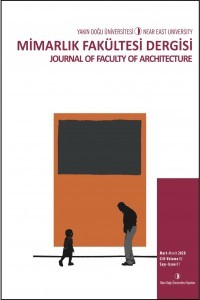Kent Mekanının Sürdürülebilirliğinde Evrensel Tasarımın Etkisi: Barış Manço Parkı
Günümüzde kent mekânlarının sürdürülebilirliğinin sağlanması elzemdir. Kent mekânlarının kullanıcısı kentte yaşayan herkestir; bu sebeple farklı bireyler tarafından kullanılabilir olmaları kaçınılmazdır. Fiziksel, zihinsel özellik ve toplumsal, sosyal, kültürel farklılık gözetmeksizin herkesin kullanımına uygun tasarımlar yapmayı amaç edinmiş evrensel tasarım kavramının kent mekânlarının tasarımında benimsenmesi önerilebilir. Bu çerçevede bu çalışmada kent mekânında evrensel tasarımın sürdürülebilirliğe katkısı literatür taramalarıyla araştırılarak, kuzey Lefkoşa‟da önemli bir konumda olan Barış Manço Parkı evrensel tasarım kavramı bağlamında gözlemlenip irdelenmiştir. Bu bağlamında park, birçok olumlu özelliğe sahiptir fakat park genelinde kullanılan malzeme sert zeminler vb ve ekipmanların kent mobilyaları vb daha çağdaş ve çevreci olması gerekmektedir. Ayrıca kent bütününde hem bu gibi kamusal alanların hem de evrensel tasarım uygulamalarının ivedilikle artırılması gerekliliği öne çıkmaktadır
Anahtar Kelimeler:
kent mekânı, sürdürülebilirlik, evrensel tasarım, Barış Manço Parkı, Lefkoşa, Kuzey Kıbrıs
The Effect of Universal Design in Urban Space Regarding Sustainability: Barış Manço Park
Nowadays, it is essential to ensure the sustainability of urban spaces. The user of urban spaces is everyone who lives in the city; therefore it is inevitable that they can be used by different individuals. The concept of universal design, which aims to make designs convenient for everyone, regardless of physical, mental trait and social, communal and cultural differences, can be suggested for the design of urban spaces. Within this framework, the contribution of universal design to sustainability in urban space has been investigated with literature review and Barış Manço Park, which has an important position in north Nicosia, has been observed and examined within the context of the concept of universal design. In this context, it can be argued that the park has many positive features, but the materials used throughout the park paving etc. and equipment urban furniture etc. need to be more contemporary and environmentally responsive. In addition, it can be suggested that both public spaces and universal design applications should be increased urgently in the city
Keywords:
urban space, sustainability, universal design, Barış Manço Park, Nicosia, North Cyprus,
___
- Beyaz Ç., & Asilsoy B. (2019). Knowledge of green buildings and environmental worldview among interior design students. International Journal of Advanced and Applied Sciences, 6 (1), pp 29-36.
- Birleşmiş Milletler, 2013. Sustainable Development Changes. World Economic and Social Survey 2013. Department of Economic and Social Affairs, United Nations Publication, (http://www.un.org/en/development/desa/policy/wess/wess current/wess2013/WESS2013.pdf).
- Blanco, H., Alberti, M., Forsyth, A., Krizek, K. J., Rodriguez, D. A., Talen, E., et al. (2009). Hot, congested, crowded and diverse: Emerging research agendas in planning.Progress in Planning, 71 (4), 153–205.
- Debnath, A. K., Chin, H. C., Haque, M. M., Yuen, B., (2014). A methodological framework for benchmarking smart transport cities. Cities 37, 47–56.
- Dostoğlu, N., Şahin, E. ve Taneli, Y. (2009). Tasarıma kapsayıcı yaklaşım: herkes için tasarım. Mimarlık Dergisi, 347, 23-27.
- Duman, Ü. (2018). Kamusal Yapılarda Evrensel Tasarımın Önemi: Girne Kaymakamlık Binası Ve Yakın Çevresinin İncelenmesi. Mimarca 85, 51-57. Lefkoşa.
- Ergenoğlu, A. S. (2013). Accessibility Awareness Among Architecture Students: Design Thinking Evaluations in Yildiz Technical University. Procedia- Social and Behavioral Journal, Elsevier LTD.(89), 6312-317.
- Evcil, A. N. (2014). Herkes için tasarım, evrensel tasarım. İstanbul: Boğaziçi Yayınları.
- Gossett A., Mirza M., Barnds A. K., & Feidt D. (2009). Beyond access: A case study on the intersection between accessibility, sustainability and universal design, Disability and Rehabilitation: Assistive Technology, 4 (6), 439-450, DOI: 10.3109/17483100903100301, (https://doi.org/10.3109/17483100903100301).
- KKTC Nüfus ve Konut Sayımı. (2011). Erişim tarihi: 25.07.2019, http://www.devplan.org/Frame-tr.html
- Korucu, (2019). Mustafa Korucu ile Kişisel Konuşma, 23 Temmuz 2019, Lefkoşa Türk Belediyesi.
- Mirgasimova A., Amrahova R., Asilsoy B. (2017). Exploring perception of public art in urban spaces among North Cyprus residents, Journal of Near Architecture, 1 (1), pp. 15-25.
- Ostroff, E. (2001). Universal Design: The New Paradigm. (Chapter 1) edited by: Preiser, W.F.E. and Ostroff, E. Universal Design Handbook. McGraw Hill. New York. USA.
- Önder, S. ve Aklanoğlu, F. (2002). Kentsel Açık Mekan Olarak Meydanların İrdelenmesi. S. Ü. Ziraat Fakültesi Dergisi. 16 (29), 96-106. Konya.
- Tandoğan, O. (2017). Evrensel Tasarım Kavramı ve Kentsel Peyzaj İle İlgili Örnekler Üzerinden Değerlendirilmesi. Artium. 5(2), 51-66. Gaziantep.
- The Center for Universal Design, (1997). The Principles of universal design, Erişim tarihi: 14.05.2017 NC, https://www.ncsu.edu/ncsu/design/cud/about_ud/udprinciplestext.htm
- The City of Calgary, (2010). Universal design handbook, building accessible and inclusive environments, Erişim tarihi: 01.07.2019, https://www.calgary.ca/CSPS/CNS/Documents/universal_design_handbook.pdf?noredirect
- Wolch J. R., Byrne J., Newell J. P. (2014). Urban green space, public health, and environmental justice: The challenge of making cities „just green enough‟, Landscape and Urban Planning, 125, pp 234–244.
- Vavik T. ve Keitsch M. M. (2010). Exploring Relationships Between Universal Design and Social Sustainable Development: Some Methodological Aspects to the Debate on the Sciences of Sustainability, Sustainable Development, 18, pp. 295–305, published online 6 July 2010 in Wiley Online Library (wileyonlinelibrary.com), DOI: 10.1002/sd.480.
- ISSN: 2687-2757
- Başlangıç: 2019
- Yayıncı: Yakın Doğu Üniversitesi
